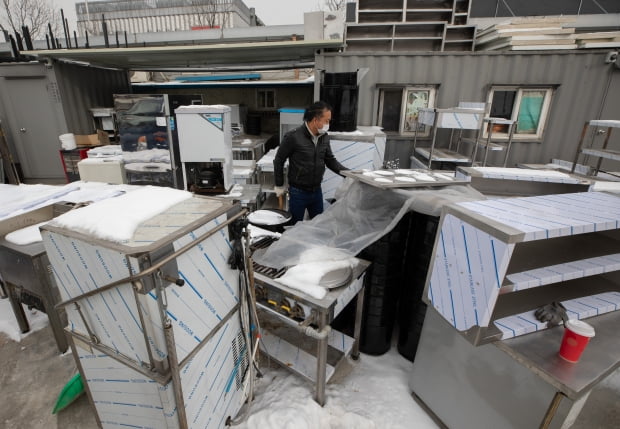
On the afternoon of the 11th, an official at the Samsung General Bowl Wholesale Center in Paldal-gu, Suwon-si, Gyeonggi-do, is arranging used kitchen utensils. Photo = News 1
In the aftermath of the novel coronavirus infection (Corona 19),’involuntary unemployed’ surpassed 2 million for the first time in history, such as closure of jobs, layoffs, and sluggish business last year. In particular, it was found that there were many involuntary unemployed in vulnerable groups such as temporary and daily workers and small workplaces.
2196,000 unemployed involuntarily last year… 48.9% year-on-year↑
Yonhap News analyzed microdata of the Economically Active Population Survey at the National Statistical Office on the 17th, and as of December last year, the number of involuntary unemployed workers less than a year after quitting was 2.196,000.
This is an increase of 48.9% from 1475,000 in 2019, the highest ever since 2000 when the unemployment statistics standard was changed. On the same basis, in 2000 (1.86 million people), when the aftermath of the International Monetary Fund (IMF) foreign exchange crisis remained, and in 2009 (1789,000 people), which was affected by the global financial crisis, the number of unemployed involuntarily increased, but last year exceeded 2 million. This is the first time.
An involuntary unemployed person is a person who quits a job due to labor market reasons, such as’closing/closing of work’,’honorary retirement/early retirement/clearance dismissal’,’temporary/seasonal completion of work’,’because of lack of work or poor business’ Means. Those who quit work voluntarily for reasons such as housework, childcare, mental and physical disabilities, retirement at retirement age, and dissatisfaction with wages are not included.
Among the reasons for unemployment of 2196,000 involuntarily unemployed last year,’completion of temporary and seasonal work’ was the most common with 1.15,000. ‘No work or poor business’ followed with 485,000 people. ‘Honorary retirement, early retirement, layoff’ was 347,000 people, and’workplace closure or closure’ was 259,000.
Compared to 2019, in particular, cases of involuntary unemployment due to job closures or retirement or dismissal have more than doubled. The number of’workplace closures and closures’ increased by 149.0%, and’honorary retirement, early retirement and layoffs’ increased by 129.8%, respectively. ‘No work or business sluggish’ and’Temporary and seasonal work completion’ increased by 42.6% and 25.6%, respectively.
Among the involuntary unemployed, 598,000 people were classified as unemployed after continuing their job search activities after unemployment, and 1598,000 people were classified as inactive because they were neither employed nor unemployed, such as giving up their job search or simply taking a break. It was counted.
Severe unemployment for the vulnerable… 63.5% are’temporary and daily workers’
Among the involuntary unemployed last year, the proportion of particularly vulnerable was very large.
In terms of employment status before unemployment, temporary workers were the most at 40.3% (885,000), followed by daily workers with 23.2% (51 million). The number of regular workers was 18.2% (400,000).
Among the self-employed, 9.6% (210,000 people) were self-employed without employees, more than 1.9% (41,000 people) self-employed with employees. This means that temporary and daily jobs were more frequent than regular jobs, and’alone boss’ had more involuntary unemployment than’boss with employees’.
In terms of the number of workers in the workplace where they quit, 44.5% (977,000 people) of 1-4 people and 20.8% (457,000 people) of 5-9 people. 65.3% of all involuntary unemployed quit working after attending small businesses with fewer than 10 people. 10 to 29 (17.4%, 383,000), 30 to 99 (9.9%, 217,000), 100 to 299 (3.2%, 70,000), 300 or more (4.2%, 93,000) As the size of the workplace increased, the number of involuntary unemployed workers tended to decrease.
In terms of gender, women (55.2%·1212,000 people) were more than men (44.8%·984,000 people). Nearly half of the involuntary unemployed, 49.4% (1085,000 people) was the head of a household (household owner).
By industry, the number of involuntary unemployed workers who were in the lodging and restaurant business hit by Corona 19 was the most, with 12.5% (274,000). Subsequently, agriculture, forestry, fishery (11.7%, 257,000 people), construction (10.5%, 230,000 people), health and social welfare service (9.6%, 211,000 people), manufacturing (9.5%, 210,000 people), public Administration, defense, and social security administration (9.1%, 200,000 people).
By age, those aged 60 or older accounted for the most at 36.8% (808,000 people). Then, in their 50s (19.4%, 425,000 people), in their 20s (18.2%, 399,000 people), in their 40s (13.2%, 290,000 people), in their 30s (10.9%, 240,000 people), 15-19 years old ( 1.6%, 35,000 people) and so on.
Reporter Jo Ara [email protected]
